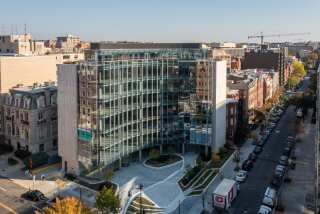IDEAS : A Mingling of the Minds Seeks New Insights : Experts are asked to step outside their specialization to bring science together.
- Share via
SANTA FE, N.M. — In an office suite near downtown, hunched behind computers or huddled in conversation, physicists offer economists new insight into world financial markets while mathematicians join with biologists to plumb the mysteries of human genetics.
Such collaborations might seem out of place at some think tanks, but at the Santa Fe Institute, interdisciplinary research is a virtue.
In its quest to comprehend such complex processes as the world economy, the functioning of the immune system or the Earth’s interdependent ecosystems, the institute brings together experts in physics, biology, astronomy, economics, archeology, computer science, applied mathematics, linguistics and sociology, to name a few.
That approach has put the institute on the frontier of a new scientific realm: the study of complex adaptive systems.
The 7-year-old institute’s alchemy may already be paying off. Scientists there have found tantalizing hints, for instance, that phenomena as diverse as an ant colony, a bird flock or a sand pile may be shaped by similar principles.
“There’s a sense here,” says Stuart Kauffman, a mathematical biologist and institute regular, “that there’s something extraordinary to be found.”
The institute was founded on the premise that science as it is usually practiced--in university settings shaped by the process of peer review and the drive to win tenure--produces great expertise within narrow specialties. It was hoped that by intermingling experts from the natural and social sciences, a better sense would emerge of how those specialties fit together.
“It’s precisely because information is getting more and more specialized and fragmented that you have to do this,” says chemist George Cowan, who recently retired as the institute’s first president. “Otherwise, you totally lose any kind of coherence.”
The idea for the institute took shape during lunch time talk among Cowan and other senior scientists at nearby Los Alamos National Laboratory. Most of the 10 founders were from the lab, but a key booster was Murray Gell-Mann, the Nobel Prize-winning astronomer and physicist from Caltech, who developed the theory that matter is made of subatomic particles called quarks.
Incorporated in 1984, the institute spent some time recruiting its “external faculty”--top scientists committed to spending one month a year in residence. In 1987, with funding from the National Science Foundation, private trusts and corporations, the institute set up shop in an old convent in Santa Fe. With a stellar faculty and four Nobel laureates on board, the institute has had little trouble attracting hundreds of scientists to conferences.
Overcrowding recently forced the institute to seek larger, temporary quarters while the search continues for a more spacious permanent setting. The institute’s annual budget of about $2.5 million pays for space, a permanent staff of about 15, five salaried postdoctoral fellows and travel stipends for visitors with no research money of their own.
Cowan’s successor as president, Los Alamos physicist Edward Knapp, expects to use the experience he gained as director of the National Science Foundation and head of the Fermi National Accelerator Laboratory in Illinois to expand the institute’s financial base through added fund raising. From the start, finding money has been harder than persuading scientists to participate.
The institute’s meetings vary widely: A two-week workshop this summer considered the sustainable use of the Earth’s resources, while the month of June was devoted to complex systems. Past meetings have examined the settlement patterns of ancient Indians in the Southwest and the physics of information.
“We’re inventing a community, which used to exist in the old days of natural philosophy, when scholars got together and talked about things,” Cowan says.
“What we do is outside the normal realm of science in this country,” adds Michael Simmons, the institute’s vice president.
Kauffman, a professor of biochemistry and biophysics at the University of Pennsylvania, is studying whether the forces that shape complex systems play a role in evolution. “I truly love the Santa Fe Institute,” says Kauffman, who adds that new approaches to uncharted areas are not without risk.
“The potential for producing hogwash,” he concedes, “is great.”






